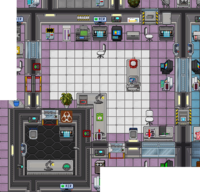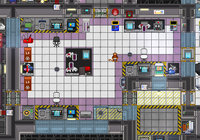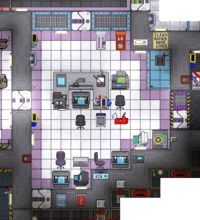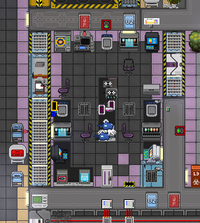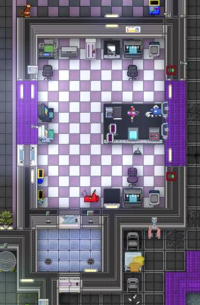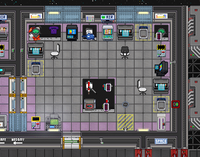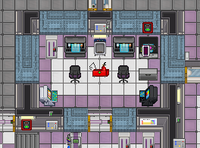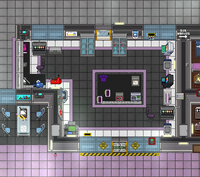Difference between revisions of "User:SaccharineChampion/Chemistry Ν"
m (Starting on GYTW) |
m (per feedback) |
||
| Line 81: | Line 81: | ||
When creating pills, patches, or ampoules, you'll be prompted to choose how many units are in each one (multiple pill/patch options only), as well as the label (which will show up as "<what you wrote> pill/patch" or "ampoule(<what you wrote>)"). Pill bottles and patch boxes work slightly differently from other containers. To get a pill or patch, click on the bottle resp. box with an empty hand while it is in your other hand. Pill bottles can be emptied by clicking the bottle with the hand holding it, dumping all pills on the floor. Patch boxes have to be opened before you can manipulate the contents. | When creating pills, patches, or ampoules, you'll be prompted to choose how many units are in each one (multiple pill/patch options only), as well as the label (which will show up as "<what you wrote> pill/patch" or "ampoule(<what you wrote>)"). Pill bottles and patch boxes work slightly differently from other containers. To get a pill or patch, click on the bottle resp. box with an empty hand while it is in your other hand. Pill bottles can be emptied by clicking the bottle with the hand holding it, dumping all pills on the floor. Patch boxes have to be opened before you can manipulate the contents. | ||
[[Image:ChemiCompilerStationary.png]] '''ChemiCompiler''': See the | [[Image:ChemiCompilerStationary.png]] '''[[ChemiCompiler]]''': A somewhat complicated machine that can automate doing chemistry for you, and in more exact amounts than you'll usually practically use. See the linked article for information on how to use it. | ||
[[Image:LabCounter.png]] '''Lab Counter''': Can hold tons and tons and ''tons'' of beakers, bottles, pills, syringes, tools, and such in its table drawer. Click-drag its sprite onto yours to access it. | [[Image:LabCounter.png]] '''Lab Counter''': Can hold tons and tons and ''tons'' of beakers, bottles, pills, syringes, tools, and such in its table drawer. Click-drag its sprite onto yours to access it. | ||
| Line 92: | Line 92: | ||
[[File:MonkeyVendingMachine.png]] '''ValuChimp''': Dispenses [[monkey]]s, a valuable commodity for the modern scientist. | [[File:MonkeyVendingMachine.png]] '''ValuChimp''': Dispenses [[monkey]]s, a valuable commodity for the modern scientist. | ||
==Ok so how do I make napalm?== | ==Ok so how do I make napalm?== | ||
| Line 223: | Line 188: | ||
Those two chemicals alone can make medbay pretty happy when supplies run low. They can also be used by yourself if you don't trust doctors to patch you up, such as when you're an [[Antagonist|antagonist]] on the run from the law, or in the middle of a busy fight such as with [[Nuclear Operative]]s. | Those two chemicals alone can make medbay pretty happy when supplies run low. They can also be used by yourself if you don't trust doctors to patch you up, such as when you're an [[Antagonist|antagonist]] on the run from the law, or in the middle of a busy fight such as with [[Nuclear Operative]]s. | ||
There are a couple of medical chems that medbay doesn't | There are a couple of medical chems that medbay either doesn't start with or has a very low starting supply of, so making them will make the doctors there extra happy. See the following. | ||
{| class="wikitable sortable" | {| class="wikitable sortable" | ||
Revision as of 18:50, 25 February 2020
Once the plan to make Chemicals their own page would be undertaken, this would be the new Chemistry page - work in progress, because I need to make the "Getting Your Toes Wet (With Acid!)" section and linking to Chemicals
This is where scientists go to brew up chemicals. Gets set on fire every other twice a round.
| SaccharineChampion/Chemistry Ν | |
| Location | |
|---|---|
|
Breeding ground for weapons of mass destruction and urine-infused smoke clouds alike. | |
| SaccharineChampion/Chemistry Ν | |
| Location | |
|---|---|
|
Breeding ground for weapons of mass destruction and urine-infused smoke clouds alike. | |
| SaccharineChampion/Chemistry Ν | |
| Location | |
|---|---|
|
Breeding ground for weapons of mass destruction and urine-infused smoke clouds alike. | |
| SaccharineChampion/Chemistry Ν | |
| Location | |
|---|---|
|
Breeding ground for weapons of mass destruction and urine-infused smoke clouds alike. | |
| SaccharineChampion/Chemistry Ν | |
| Location | |
|---|---|
|
Breeding ground for weapons of mass destruction and urine-infused smoke clouds alike. | |
| SaccharineChampion/Chemistry Ν | |
| Location | |
|---|---|
|
Breeding ground for weapons of mass destruction and urine-infused smoke clouds alike. | |
| SaccharineChampion/Chemistry Ν | |
| Location | |
|---|---|
|
Breeding ground for weapons of mass destruction and urine-infused smoke clouds alike. | |
| SaccharineChampion/Chemistry Ν | |
| Location | |
|---|---|
|
Breeding ground for weapons of mass destruction and urine-infused smoke clouds alike. | |
|
Research Director, Scientist, Medical Director, Medical Doctor, Roboticist, Geneticist, Head of Security, Security Officer, Detective, Janitor | |
Oh boy I can't wait to melt my eyebrows off!
Here's a quick look at the devices scattered across the room.
![]() Chem Dispenser: Dispenses a whole slew of chemicals. Use a beaker (or any liquid-bearing container) on it to insert it, then use the machine to pick chemicals. You can choose to remove unwanted chemicals (isolate removes all chemicals BUT the selected one). When you're done, eject the beaker from the menu.
Chem Dispenser: Dispenses a whole slew of chemicals. Use a beaker (or any liquid-bearing container) on it to insert it, then use the machine to pick chemicals. You can choose to remove unwanted chemicals (isolate removes all chemicals BUT the selected one). When you're done, eject the beaker from the menu.
You can also make pre-set chemical groups through the Group button, so that the chem dispenser dispenses certain reagents automatically when you click one of the Group buttons. An example reagent group:
water=1;chlorine=1;sodium=1
Notice: no spaces needed, no semi-colon at the end necessary. For fairly obvious reasons, you can't do things like sulfuric_acid=1; the chem dispenser simply doesn't dispense such reagents, just their ingredients. You must do hydrogen=1;oxygen=1;sulfur=1 instead.
![]() Reagent Extractor: Converts certain items (usually food items or plants but not always) into chemical reagents that are stored into one of two internal tanks or an inserted container.
Reagent Extractor: Converts certain items (usually food items or plants but not always) into chemical reagents that are stored into one of two internal tanks or an inserted container.
![]() Heating/Cooling Unit: Used to chill or heat containers. Use the menu to set a target temperature (Tip: click the number itself to punch in a number instead of clicking + and - over and over again.), and press Activate to start the heating/cooling process.
Heating/Cooling Unit: Used to chill or heat containers. Use the menu to set a target temperature (Tip: click the number itself to punch in a number instead of clicking + and - over and over again.), and press Activate to start the heating/cooling process.
![]() CheMaster 3000: Used to turn chemicals into pills, medical patches, medicine bottles, or ampoules, though it can also isolate or remove reagents from the inserted beaker. If you need more information, click the Analyze option next to the reagent name, and the CheMaster will briefly describe what it does or at least what it is (which may or may not be helpful). The Analyze option can also conduct blood tests if you lack other tools (reagent scanner, upgraded health analyzer): draw blood and analyze it with the CheMaster in the pharmacy.
CheMaster 3000: Used to turn chemicals into pills, medical patches, medicine bottles, or ampoules, though it can also isolate or remove reagents from the inserted beaker. If you need more information, click the Analyze option next to the reagent name, and the CheMaster will briefly describe what it does or at least what it is (which may or may not be helpful). The Analyze option can also conduct blood tests if you lack other tools (reagent scanner, upgraded health analyzer): draw blood and analyze it with the CheMaster in the pharmacy.
When creating pills, patches, or ampoules, you'll be prompted to choose how many units are in each one (multiple pill/patch options only), as well as the label (which will show up as "<what you wrote> pill/patch" or "ampoule(<what you wrote>)"). Pill bottles and patch boxes work slightly differently from other containers. To get a pill or patch, click on the bottle resp. box with an empty hand while it is in your other hand. Pill bottles can be emptied by clicking the bottle with the hand holding it, dumping all pills on the floor. Patch boxes have to be opened before you can manipulate the contents.
![]() ChemiCompiler: A somewhat complicated machine that can automate doing chemistry for you, and in more exact amounts than you'll usually practically use. See the linked article for information on how to use it.
ChemiCompiler: A somewhat complicated machine that can automate doing chemistry for you, and in more exact amounts than you'll usually practically use. See the linked article for information on how to use it.
![]() Lab Counter: Can hold tons and tons and tons of beakers, bottles, pills, syringes, tools, and such in its table drawer. Click-drag its sprite onto yours to access it.
Lab Counter: Can hold tons and tons and tons of beakers, bottles, pills, syringes, tools, and such in its table drawer. Click-drag its sprite onto yours to access it.
![]()
![]() Beakers: Holds chemicals. Standard ones hold 50 units, large ones 100. Click on another beaker or similar while the beaker is in your hand to transfer up to 10 units of chems into it. Click-drag its sprite into another beaker or similar (neither have to be in your hand) to transfer as many reagents as possible into the receiving beaker.
Beakers: Holds chemicals. Standard ones hold 50 units, large ones 100. Click on another beaker or similar while the beaker is in your hand to transfer up to 10 units of chems into it. Click-drag its sprite into another beaker or similar (neither have to be in your hand) to transfer as many reagents as possible into the receiving beaker.
- Note: Generally, the exact contents of beakers and other reagent containers can't be examined directly. A pair of spectroscopic goggles or a reagent scanner (PDA or separate) are recommended.
![]() Glass Recycler: Put glass shards and glassware into it to make other, bigger types of glassware. Most useful for creating large beakers.
Glass Recycler: Put glass shards and glassware into it to make other, bigger types of glassware. Most useful for creating large beakers.
![]() ValuChimp: Dispenses monkeys, a valuable commodity for the modern scientist.
ValuChimp: Dispenses monkeys, a valuable commodity for the modern scientist.
Ok so how do I make napalm?
Safety First
Hold your horses, pyromaniacs. First things first, we need to discuss some important... *groan* safety tips:
- Mix potentially-explosive chemicals in the Test Chamber. One is the tiny room in the page image and another is due north of the lab, both with reinforced floors and walls that can tank explosions better. Keeping other scientists and the mixing lab out of the collateral damage is one less reason for them to
murder youleave you to fry from your own fireball for potentially ruining their round. And if you can't mix the explosive stuff in another room, at the very least warn your colleagues before you do it. - Always wear your standard-issue gas mask and a biosuit + bio hood from the closets. This can't be stressed enough; some chemicals are accompanied with a "The solution generates a strong vapor!" message upon successful mixing, giving everyone adjacent to the tile a big whiff of the chemical that was just mixed on it. The full gas mask/biosuit set immunizes you to this and most chemical smokes and TOUCH reactions, protecting you from your colleagues' shenanigans as well as your own. There is no reason not to do this unless you're trying to choke on your own poisons.
- Don't mix random chemicals Similar to real life, if you aren't careful, you might cause a fire, explosion, implosion, and/or flash or catch a whiff of some toxic fumes. This is why it's important to have a gas mask and a biosuit + bio hood if you don't know what you're doing.
- Pay attention to what other scientists are doing and don't get in their way. For example, if someone places a beaker into a reagent heater and runs away from it, he's probably anticipating a fireball or smoke of some degree and it's wise not to go look at, lest you get a face-full of it.
- Make liberal use of stabilizing agent. If you see a recipe that mentions stabilizing agent, always use it when mixing the recipe in question so it doesn't literally blow up in your face. It's a good practice to do this for recipes you're unfamiliar with. Be wary, however, that stabilizing agent doesn't work with everything - these cases should be mixed in the aforementioned test chamber.
- Test harmful or unknown chemicals on monkeys, NOT other people. This is why you have the ValuChimp. Monkeys are NPCs with damage counters just like that of a human's, so they'll provide an accurate representation of what would happen if you use that chemical mix on a human. This is doubly important if you're a round antagonist, as you will need to make sure your deathchems actually cause death instead of just provoking your target into toolboxing you.
Got all that? Good. Now we can get started with making napalm.
Discount Dan's Quik-Tips for Getting Acquainted with Chemistry
So, turns out making napalm isn't terribly complex at all. But there's more to chemistry than just making napalm--so much more! It's almost overwhelming. Where does an aspiring chemist start?
- Begin with the basics. Start with the stuff in basic compounds table. Know each one by heart, for they are at the heart of many recipes. Luckily, there aren't many to learn.
- Don't start with deadly recipes. One of the primary benefits of learning the recipes for healing chemicals first is that when you DO start to learn harmful recipes, you'll be able to heal yourself when you fuck up.
- Don't over-think the recipes.
- The recipes for chems from real-life generally follow a comfortably simplified version of the actual process; for example, methamphetamine is based on the Nagai route, while sulfuric acid is just the elements that make up the molecule.
- The ones for entirely fictional chems tend be somewhat arbitrary, but for some, there's some simple logic linking them, e.g. glitter needs shiny stuff and a paper base for it, while flaptonium involves bird-related things. Even some of said arbitrary ones often use plasma for that "magical sci-fi chemical that can do anything".
- This holds particularly true for the secret chems:
- For ones that are based on real life, such as nitroglycerin, study the general process and try to replicate it in SS13 with "equivalents"; for most, you usually don't have to go further than a Wikipedia page.
- For fictional chems, such as mutini, think about which chems can best replicate their effects. Some, like Crabby Party Secret Formula, are just jokes, where the hint is the punchline linking the ingredients together.
- If you get stuck, don't be afraid to ask for hints. In fact, there's even a Spacebux item called a "Chem Hint Scroll" that provides a clue for a random ingredient for a random chem.
- Look beyond the chem dispenser!
- The Botanists can mass-produce certain chems through the power of botany, significantly easing your workload. There are even a few chems that only obtained from certain plants. Don't be afraid to ask them to grow a few things.
- You can insert certain items into the Reagent Extractor, usually food and plant products, to get certain chems; many chems can only be obtained this way. Learn it and love it; neither are too hard to do. You'll use it a lot in your chemistry career; just look at all the places in the tables below that go "Extract from...".
- Discount Dan's products from red snack machines contain a true smorgasbord of chemicals. You might surprised (and maybe a little queasy) at what's in those noodle cups!
- There are many "designer drug" pills scattered in random places on the station/ship and elsewhere, often in pill bottles named in-game as "pill bottle (????)". Who knows what magical toxic treasures they contain!?
Getting Your Toes Wet
Need a bit more direction before heading off into the dangerous world of chemistry? This section describes a few specific commonly used and requested chems in ascending order of difficulty.
Acid (Not the Fun Kind)
Acids happen to simultaneously have some of the simplest recipes, the most obvious harmful effects, and somewhat high usage. You'll be particularly using your good friend Sulfuric Acid for a couple of recipes.
| Chemical Name | Recipe | Effects |
|---|---|---|
| Sulfuric Acid | Sulfur (1) + Hydrogen (1) + Oxygen (1) => Sulfuric Acid (2) | Deals decent damage scaling with quantity. Sometimes melts items. Used in some other chems' recipes! |
| Fluorosulfuric Acid | Sulfuric Acid (1) + Fluorine (1) + Hydrogen (1) + Potassium (1) @ 374 K => Fluorosulfuric Acid (3) | Deals even more damage, again scaling with quantity. Always melts items upon application, and melts headgear if 9 or more units are splashed on a person. |
Since Sulfuric Acid is made entirely of chemicals in the chem dispenser, you only need to put a beaker in and hit each of those chemicals once. Simple! Once you have some sulfuric acid, you can add the fluorine, hydrogen, and potassium - again, all found in the dispenser - but then you will need to heat up the beaker. Put it in the Heating/Cooling unit and set the temperature really high - just setting it to the required temperature of 374K is slow and won't cut it compared to setting it to the maximum temperature and just removing it once it reacts. And once it does react - congratulations, you have a beaker of Wizard-busting, day-ruining acid!
Getting Medbay to Love You
If you have a more pacifistic slant, you can make most of the medicines which medbay enjoys using. Two of the most commonly used medical chems are the following; they're fortunately pretty simple.
| Chemical Name | Recipe | Effects |
|---|---|---|
| Styptic Powder | Aluminium (1) + Oxygen (1) + Hydrogen (1) + Sulfuric Acid (1) => Styptic Powder (4) | Slows down bleeding and heals BRUTE damage. Only apply topically, such as with patches - ingestion in pill or drink form poisons the patient! |
| Silver Sulfadiazine | Ammonia (1) + Silver (1) + Sulfur (1) + Oxygen (1) + Chlorine (1) => Silver Sulfadiazine (5) | Heals BURN damage. Just like styptic powder, apply it topically or it will poison whoever ingests it! |
Similarly to Fluorosulfuric Acid above, to make styptic powder, you first need to brew up some sulfuric acid and add some other chemicals from the dispenser. Unlike the acid, it doesn't require any heating, making it quick and easy. Silver sulfadiazine is a bit more involved because it uses Ammonia, which has the following recipe:
| Chemical Name | Recipe | Effects |
|---|---|---|
| Ammonia | Hydrogen (3) + Nitrogen (1) => Ammonia (3) | Doesn't actually do much on its own besides help the Botanists' plants - it does get used in a lot of recipes, though! |
This is an example of a chemical with a non-balanced recipe; pay careful attention to the ratios, or you may end up with leftover unwanted reagents! You'll also likely need to remove some of the resulting ammonia from the beaker to fit in silver sulfadiazine; you can't fit 30 each of ammonia, silver, sulfur, oxygen, and chlorine in a typical 100u beaker, much less a 50u one.
Those two chemicals alone can make medbay pretty happy when supplies run low. They can also be used by yourself if you don't trust doctors to patch you up, such as when you're an antagonist on the run from the law, or in the middle of a busy fight such as with Nuclear Operatives.
There are a couple of medical chems that medbay either doesn't start with or has a very low starting supply of, so making them will make the doctors there extra happy. See the following.
| Chemical Name | Recipe | Effects |
|---|---|---|
| Synthflesh | ||
| Perfluorodecalin | ||
| Cryoxadone |
